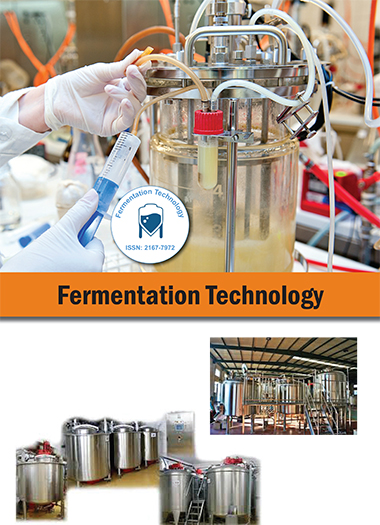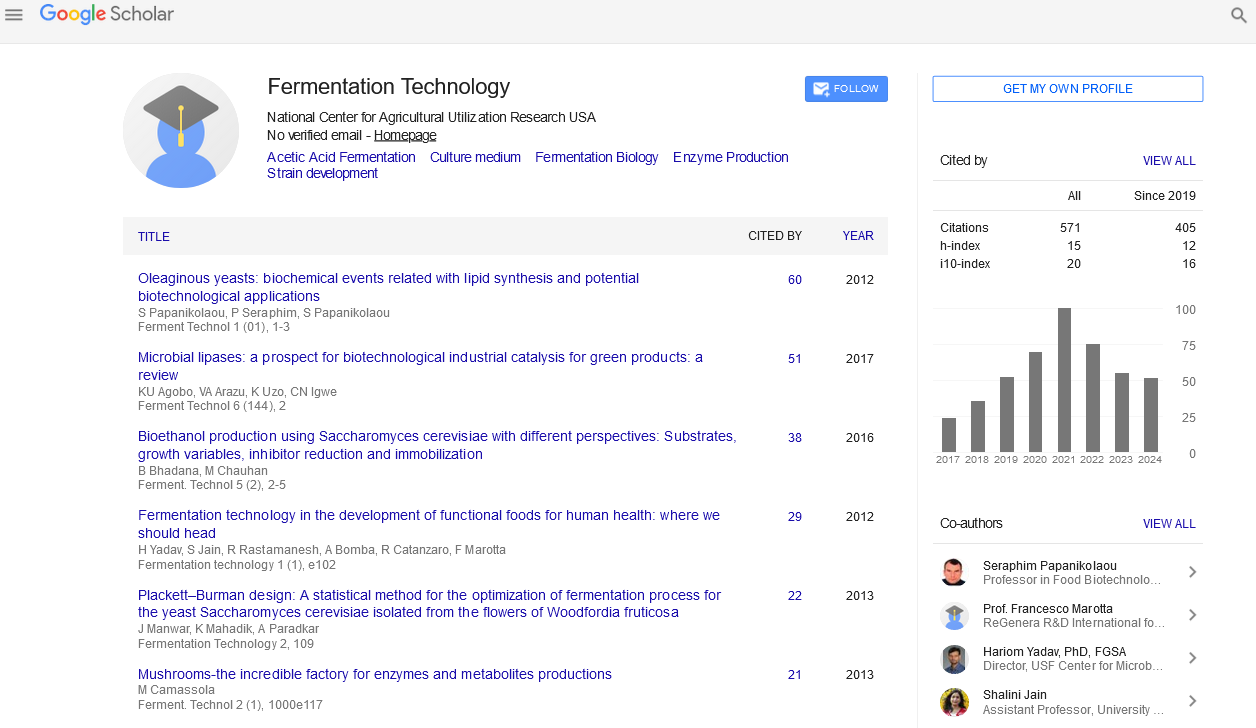Indexed In
- Open J Gate
- Genamics JournalSeek
- Access to Global Online Research in Agriculture (AGORA)
- RefSeek
- Hamdard University
- EBSCO A-Z
- OCLC- WorldCat
- Publons
Useful Links
Share This Page
Journal Flyer

Open Access Journals
- Agri and Aquaculture
- Biochemistry
- Bioinformatics & Systems Biology
- Business & Management
- Chemistry
- Clinical Sciences
- Engineering
- Food & Nutrition
- General Science
- Genetics & Molecular Biology
- Immunology & Microbiology
- Medical Sciences
- Neuroscience & Psychology
- Nursing & Health Care
- Pharmaceutical Sciences
Perspective - (2024) Volume 13, Issue 1
Optimizing Biofuel Production: Advances in Synthetic Biology for Mixed Sugar Fermentation
Amelia Aiden*Received: 26-Feb-2024, Manuscript No. FMT-24-25559; Editor assigned: 28-Feb-2024, Pre QC No. FMT-24-25559 (PQ); Reviewed: 13-Mar-2024, QC No. FMT-24-25559; Revised: 20-Mar-2024, Manuscript No. FMT-24-25559 (R); Published: 27-Mar-2024, DOI: 10.4172/2167-7972.24.13.175
Description
The fermentation of mixed sugars, such as glucose, xylose, and arabinose, is a significant challenge in bioethanol production. In general, Saccharomyces cerevisiae strains struggle to efficiently ferment these sugars simultaneously, limiting the overall efficiency of biofuel production. However, recent advancements in synthetic biology have opened up methods for engineering yeast strains with specialized metabolic pathways, enabling them to ferment specific sugars. This article aims to explore the fundamental findings of this study and their significance for bioethanol production.
The study utilized a synthetic biology approach to engineer Saccharomyces cerevisiae strains capable of fermenting single sugars —glucose, xylose, and arabinose—efficiently. The researchers completed a consortium comprising these specialized strains, each optimized for metabolizing a specific sugar. Strain engineering involved genetic modifications to enhance sugar transport, metabolic flux, and cofactor balance. The fermentation experiments were conducted in controlled bioreactor conditions, monitoring sugar consumption, ethanol production, and byproduct formation over time. Additionally, transcriptomic analysis provided insights into gene expression dynamics during mixed sugar fermentation.
This study demonstrated the effectiveness of the synthetic consortium in fermenting glucose-xylose-arabinose mixtures. Compared to standard yeast strains, the consortium exhibited significantly higher sugar utilization rates and ethanol yields. Significantly, individual strains within the consortium displayed substrate specificity, prioritizing the fermenting of their designated sugar while coexisting pleasantly with other strains. This collaborative behavior facilitated efficient utilization of all sugars in the mixture, maximizing ethanol production.
Furthermore, transcriptomic analysis revealed complex regulatory mechanisms primary sugar metabolism in the synthetic consortium. Differential gene expression patterns highlighted the coordinated response of individual strains to varying sugar concentrations, optimizing metabolic flux for efficient fermentation. Moreover, metabolic engineering strategies employed in strain construction resulted in balanced cofactor utilization, minimizing metabolic limitations and improving overall fermentation performance.
The findings of this study hold significant potential for bioethanol production and biotechnological applications. The synthetic consortium approach presents an adaptable and sustainable solution to the challenge of mixed sugar fermentation. By controlling the complementary metabolic capabilities of specialized yeast strains, this strategy allows efficient conversion of various sugar sources into biofuels. This adaptability extends beyond ethanol production, with potential applications in the synthesis of other valuable chemicals and pharmaceuticals.
Moreover, the synthetic consortium highlights the power of synthetic biology in addressing complex biological challenges. By systematically engineering microbial consortia with defined functionalities, researchers can design customized solutions for various industrial processes. This connected approach permits adjustment of consortium composition and dynamics, optimizing performance under specific operating conditions. Additionally, advancements in high-throughput screening and computational modeling facilitate the rational design of synthetic consortia, accelerating the development of novel biotechnological solutions.
However, several challenges and opportunities permit further investigation in this field. The scalability and stability of synthetic consortia in industrial-scale fermentations remain basic considerations. Strategies for maintaining consortium quality and preventing strain dominance or contamination are essential for practical implementation. Furthermore, continuous optimization of strain performance and metabolic pathways is essential for enhancing fermentation efficiency and product yields.
Additionally, exploring the ecological significance of synthetic consortia in natural environments is essential for assessing their environmental impact. While engineered microbes offer potential solutions for bioproduction, concerns regarding biosafety and ecological stability require careful consideration. Understanding the interactions between synthetic consortia and native microbial communities is vital for estimation and addressing potential ecological risks.
In conclusion, the fermentation of mixed sugars by a synthetic consortium of single-sugar-fermenting Saccharomyces cerevisiae strains represents a change of opinion in bioethanol production. By controlling the principles of synthetic biology, researchers have overcome the constant challenges associated with traditional yeast strains and prepared for sustainable and efficient biorefineries. The synergistic interactions between specialized strains within the consortium represent the potential of engineered microbial consortia to control the full value of renewable sources. Moving forward, continued advancements in synthetic biology and bioprocess engineering will drive innovation in biotechnology, offering transformative solutions to global challenges in energy, the environment, and healthcare.
Citation: Aiden A (2024) Optimizing Biofuel Production: Advances in Synthetic Biology for Mixed Sugar Fermentation. Ferment Technol. 13:175.
Copyright: © 2024 Aiden A. This is an open-access article distributed under the terms of the Creative Commons Attribution License, which permits unrestricted use, distribution, and reproduction in any medium, provided the original author and source are credited.

